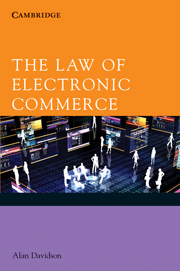Book contents
- Frontmatter
- Contents
- Acknowledgements
- Table of Cases
- Table of statutes
- 1 The law of electronic commerce
- 2 The rule of cyberspace
- 3 Electronic commerce and the law of contract
- 4 Shrinkwrap, clickwrap and browsewrap contracts
- 5 Electronic signatures
- 6 Copyright issues in electronic commerce
- 7 Electronic commerce – trade marks, patents and circuit layouts
- 8 Domain names
- 9 Domain name disputes
- 10 Uniform domain name dispute resolution policies
- 11 Jurisdiction in cyberspace
- 12 Defamation in cyberspace
- 13 Privacy and data protection in cyberspace
- 14 Electronic mail and online presence
- 15 National electronic surveillance
- 16 Cybercrime
- 17 Evidence of electronic records
- 18 Censorship – Broadcast and online content regulation
- 19 An international perspective
- Appendix A Electronic Transactions (Victoria) Act 2000
- Appendix B UNCITRAL Model Law on Electronic Commerce
- Appendix C Selected provisions Copyright Act 1968 (Cth)
- Appendix D ICANN Uniform Dispute Resolution Policy (UDRP)
- Appendix E .au Dispute Resolution Policy (auDRP)
- Appendix F National Privacy Principles
- Index
Appendix A - Electronic Transactions (Victoria) Act 2000
Published online by Cambridge University Press: 05 June 2012
- Frontmatter
- Contents
- Acknowledgements
- Table of Cases
- Table of statutes
- 1 The law of electronic commerce
- 2 The rule of cyberspace
- 3 Electronic commerce and the law of contract
- 4 Shrinkwrap, clickwrap and browsewrap contracts
- 5 Electronic signatures
- 6 Copyright issues in electronic commerce
- 7 Electronic commerce – trade marks, patents and circuit layouts
- 8 Domain names
- 9 Domain name disputes
- 10 Uniform domain name dispute resolution policies
- 11 Jurisdiction in cyberspace
- 12 Defamation in cyberspace
- 13 Privacy and data protection in cyberspace
- 14 Electronic mail and online presence
- 15 National electronic surveillance
- 16 Cybercrime
- 17 Evidence of electronic records
- 18 Censorship – Broadcast and online content regulation
- 19 An international perspective
- Appendix A Electronic Transactions (Victoria) Act 2000
- Appendix B UNCITRAL Model Law on Electronic Commerce
- Appendix C Selected provisions Copyright Act 1968 (Cth)
- Appendix D ICANN Uniform Dispute Resolution Policy (UDRP)
- Appendix E .au Dispute Resolution Policy (auDRP)
- Appendix F National Privacy Principles
- Index
Summary
Part 1—Preliminary
Purposes
The purposes of this Act are—
(a) to recognise that transactions effected electronically are not by that reason alone invalid;
(b) to provide for the meeting of certain legal requirements as to writing and signatures by electronic communication;
(c) to permit documents to be produced to another person by electronic communication;
(d) to permit the recording and retention of information and documents in electronic form;
(e) to provide for the determination of time and place of dispatch and receipt of electronic communications;
(f) to stipulate when an electronic communication will bind its purported originator.
Commencement
This Act comes into operation on 1 September 2000.
Definitions
(1) In this Act—
consent includes consent that can reasonably be inferred from the conduct of the person concerned, but does not include consent given subject to conditions unless the conditions are complied with;
data includes the whole or part of a computer program within the meaning of the Copyright Act 1968 of the Commonwealth;
data storage device means any article or material (for example, a disk) from which information is capable of being reproduced, with or without the aid of any other article or device;
electronic communication means—
(a) a communication of information in the form of data, text or images by means of guided or unguided electromagnetic energy, or both; or
(b) a communication of information in the form of sound by means of guided or unguided electromagnetic energy, or both, where the sound is processed at its destination by an automated voice recognition system;
- Type
- Chapter
- Information
- The Law of Electronic Commerce , pp. 348 - 356Publisher: Cambridge University PressPrint publication year: 2009
- 3
- Cited by



